sweet clover
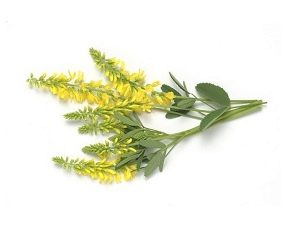
Sweet clover (Latin Melilotus) is a herbaceous plant of the legume family. Its Russian name is associated with the word "donna", which was once called gout. The Latin name is derived from the Greek words "chalk" and "lotus", meaning honey and fodder grass.
The plant is also called bottom grass, barkun, donets, hargun, hare chill, ragwort, sticky, burkun, wild hop, stable, sweet clover and wild buckwheat.
Titles in other languages:
- English Sweet clover, field melilot;
- German Honiglee.

Appearance
The height of the sweet clover is up to two meters. The plant has a branched stem, tap root, trifoliate leaves with stipules, white or yellow drooping long flowers. The plant blooms in summer - from June to August.



Kinds
Many species of this plant are known - jagged, Sicilian, Italian, fragrant, Volga, rough, beautiful, Polish and others.
Traditional and official medicine uses only two types of sweet clover, which we will consider.
White sweet clover
An annual or biennial plant with a straight stem up to 170 cm in height. The sheet plate is divided into three parts. Tiny white flowers are collected in elongated brushes. Flowering occurs in the summer, lasting one month. Its gentle pleasant aroma is similar to coumarin, but not close. This species is the best honey plant.

Melilot officinalis
Biennial plant up to one and a half meters in height. Stem glabrous, leaves trifoliate. The flowers are yellow, very small in long racemes.The aroma is strong, coumarin. Blooms all summer and the first month of autumn.
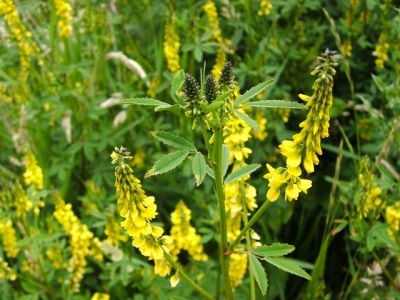
Where does it grow
You can find sweet clover in both Asia and Europe. The plant has spread extensively around the planet. It is often found in meadows, in the forest-steppe zone, in beams, on the edges and in the steppes.

blank
- Harvesting is carried out during the flowering period.
- The tops of the sweet clover are cut with a knife, obtaining raw materials up to thirty centimeters long. Thick and too coarse stems, as well as plants on roadsides, are not cut. Sweet clover is harvested only in dry weather, as a wet plant quickly deteriorates.
- After cutting, the plant is immediately sent to dry. It is laid out on the street, hidden under a canopy, or in an attic with excellent ventilation (it is important that the temperature is up to +40 degrees).
- Raw materials should be laid out on fabric or on paper with a layer of up to seven centimeters. It is periodically turned over.
- When the stems break easily, drying is completed. It is necessary to ensure that the raw material does not dry out, otherwise the leaves will crumble.
- Dried sweet clover can be stored for up to two years.

Peculiarities
- Dried sweet clover has a bitter-salty taste.
- The smell of the dried plant resembles fresh hay (it is called coumarin).
- Sweet clover is used to improve soil and restore soil fertility.
- The plant is also medicinal, melliferous and fodder.
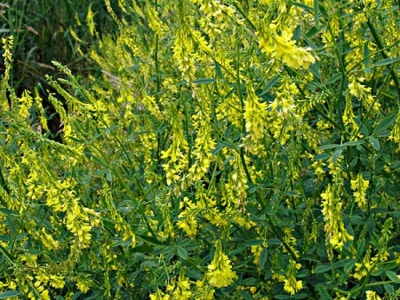
Nutritional value and calories
For 100 g sweet clover:
| Squirrels | Fats | Carbohydrates | calories |
| 0.8 gr. | 0 gr. | 81.5 gr. | 309 kcal |
Chemical composition
The clover contains:
- glycosides (one of them is coumarin, which provides the flavor of the plant);
- essential oil;
- cymarin;
- protein;
- acids - coumaric, ascorbic, melilotic;
- fatty substances;
- purine derivatives;
- melilotol;
- flavonoids;
- tannins;
- Sahara;
- choline;
- slime.
When sweet clover begins to rot, dicoumarin is formed in it.

Beneficial features
The plant has the following effect:
- expectorant;
- lactagon;
- painkillers;
- antiseptic;
- laxative;
- promotes wound healing;
- helps with fever.

Contraindications
The plant is not used for:
- pregnancy;
- kidney disease;
- problems with blood clotting;
- internal bleeding.
When using sweet clover, remember the poisonousness of the plant - never exceed the dosage and use it better as part of the collection.
Excessive and too long consumption of sweet clover can cause CNS depression, drowsiness, dizziness, liver damage, headaches and other problems. Animals that consume rotten hay containing sweet clover are poisoned by dicoumarin.
Honey
Bees collect honey from sweet clover all summer.
The color of honey is determined by the type of plant and the soil in which it grew. It is white to amber, sometimes with a golden and greenish tint.
Sweet clover honey smells very pleasant.
Yellow sweet clover produces honey, which has a very mild taste and a delicate smell.
White sweet clover gives honey with a sharper, slightly bitter taste and smell with hints of vanilla.

Benefit
Honey obtained from sweet clover is very useful. It contains fructose (40 percent) and glucose (about 37 percent).
Applying sweet clover honey externally and internally, it has useful properties:
- Increases energy levels and body tone.
- It has an analgesic and anti-inflammatory effect in diseases of the respiratory tract.
- Improves the condition of people with hypertension and heart disease.
- Has a diuretic effect.
- Eliminates dizziness and headaches.
- Stimulates lactation.
With long-term storage, sweet clover honey becomes a viscous mass of white or yellow color.
calories
Calorie content of 100 grams of sweet clover honey - 314 kcal.
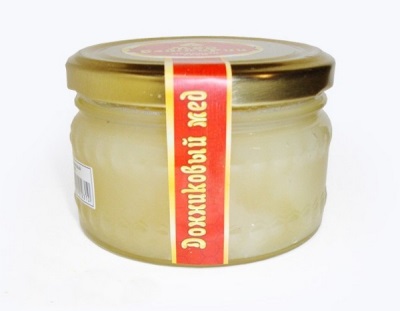
Application
In cooking
- Only yellow sweet clover is used for food, since white sweet clover is classified as a poisonous plant.
- There are many recipes that include sweet clover, but you should not abuse the addition of this aromatic herb (there is a risk of headaches and nausea).
- Fresh young sweet clover is added to salads, okroshka, soups.
- The crushed dried plant is used as a seasoning, adding to sauces, drinks, snacks and second courses.



Okroshka with clover
In half a liter of bread kvass, you need to put 70 grams of boiled beef cut into pieces, 50 grams of boiled potatoes, a hard-boiled egg and 50 grams of fresh cucumber. Clover leaves (20 grams), as well as 25 grams of onion, chop and rub with mustard, sugar and salt, add to okroshka. Season with sour cream to taste.

Sweet clover root garnish
Wash the roots of a young plant well and, after salting, fry with vegetable oil. This side dish can be served with fish or meat.
Meat stewed with sweet clover
Cut 250 grams of meat into pieces and fry a little. Put it in a goose dish and add 50 grams of chopped onion, 50 grams of coarsely grated carrots, 200 grams of chopped potatoes and 20 grams of sweet clover leaves. Also, you need to put pepper, bay leaf and dill seed in the goose bowl, then pour everything with water so that it covers the ingredients. Simmer the dish until cooked on a small fire.

Sweet clover drink
Bring a liter of water to a boil, put 10 grams of inflorescences and sweet clover leaves into it, add sugar to taste and about 100 ml of cherry or cranberry juice. When the drink boils, remove from heat and cool.

See below for details.
In medicine
- For medical purposes, both yellow and white sweet clover are used. Leaves, stems, and flowers of these plants are also used.
- Since the white sweet clover is poisonous, only experienced healers risk using it.
- The plant contains coumarin, which has a depressant effect on the nervous system. This substance prevents convulsions, increases the number of leukocytes.
- Sweet clover is used for migraine, insomnia, hysteria, headaches, menopause, flatulence, bronchitis and other problems.
- The herbaceous part of sweet clover is included in the fees, from which poultices are made. Also, the plant is a component of a green plaster that helps against corns and abscesses.
- After insisting dry sweet clover (2 small spoons), filled with boiling water (half a glass), for four hours, it is used to stimulate lactation, divided into three portions.
- Decoctions, as well as infusions prepared from sweet clover, are effective for otitis media, mastitis, purulent wounds, boils.
- Homeopaths use sweet clover in the preparation of drugs against psychosis.
- Traditional medicine considers the plant an excellent laxative, and also prescribes sweet clover for hypertension, pain, lung diseases, gynecological pathologies, bloating and other problems.
- From the leaves of sweet clover, the drug meliocin is made, which has a stimulating effect.

Infusion for headaches, hypertension, insomnia
Infuse sweet clover grass filled with boiled cold water (two glasses) in a closed container (take two teaspoons). Take the infusion two or three times a day for half a glass.
For baths and compresses
Prepare the infusion by placing a closed container with 2 tables. spoons of sweet clover and 500 ml of water on a hot stove.
Tincture for migraine
Pour sweet clover grass with 40% alcohol (1 to 10) and place in a dark place for 10-15 days. After straining, the tincture can be stored in the refrigerator for up to two years. It can be used either internally or externally - fifteen drops each.
Poultices
They can be prepared from flowers steamed with boiling water, or from crushed leaves.
With hemorrhoids
Take two parts of multi-colored and lush carnations, as well as one part of mountaineer, sweet clover and goose cinquefoil. After grinding everything in a mortar or coffee grinder, take 20 grams of the resulting powder and grind it with 80 grams of fat or lard (melt it first). Keep this mixture for four hours in a water bath, and then strain while still hot.
At home
Sweet clover is used as:
- fragrance in tobacco products;
- soap fragrance;
- fodder plant;
- honey plant;
- soil improver.

Varieties
The plant is considered a valuable crop and is grown in different climatic zones. Sweet clover is represented by many varieties, of which more and more are constantly appearing. White sweet clover is represented by varieties Volzhanin, diomede, Rybinsk, Volga, steppe and others. Medicinal sweet clover is represented by the varieties Lazar, Siberian, Golden, Alsheevsky and others.

cultivation
Sweet clover seeds germinate at a temperature of +2+4 degrees. Only ripe seeds or slightly unripe ones germinate well. Before sowing, they are scarified. In the first year, the sweet clover develops a root and a green part. The plant begins to bloom a year after planting.
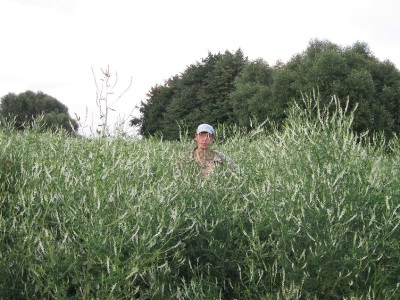
Due to the presence of a strong root system, sweet clover is not picky about the soil. Also, the plant is drought tolerant, so it does not need to be constantly watered. Only acidic soil and excess moisture have a bad effect on sweet clover.


















Oh, we have a dime a dozen in our country house. And I didn't know that the sweet clover was so useful.
So collect on health!